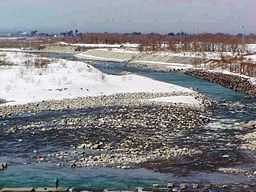Kurobe River
From Wikipedia, the free encyclopedia
This article is about the river in Toyama Prefecture. For the river in Chiba Prefecture, see Kurobe River (Chiba Prefecture).
| Kurobe River (Kurobe-gawa) | |
| 黒部川 | |
| River | |
 | |
| Name origin: Ainu | |
| Country | Japan |
|---|---|
| State | Toyama |
| Region | Chūbu |
| District | Shimoniikawa |
| Municipalities | Kurobe, Nyūzen, Toyama |
| Source | Mount Washiba |
| - location | Toyama, Toyama, Japan |
| - elevation | 2,924 m (9,593 ft) |
| - coordinates | 36°24′10″N 137°36′18″E / 36.40278°N 137.60500°E |
| Mouth | Sea of Japan |
| - location | Kurobe and Nyūzen, Toyama, Japan |
| - elevation | 0 m (0 ft) |
| - coordinates | 36°55′17″N 137°25′28″E / 36.92139°N 137.42444°E |
| Length | 85 km (53 mi) |
| Basin | 667 km2 (258 sq mi) |
| Discharge | |
| - average | 12.18 m3/s (430 cu ft/s) |
The Kurobe River (黒部川 Kurobe-gawa) is a river in Toyama Prefecture, Japan. 86 km in length, it has a watershed of 689 km².
The river rises from Mount Washiba in the Hida Mountains and carves the deep valley known as the Kurobe gorge. It comes out of the mountains at Unazuki and forms an alluvial fan which directly sinks into the Sea of Japan.
The Kurobe River's rich flow and steep gradient offer good conditions for hydroelectricity. The Kurobe Dam is the tallest dam in Japan.
The name Kurobe is meaningless in Japanese. It appears to be an Ainu name, kur pet [kuɾᵘbet] 'shady river'.[1]
References
- ↑ Vovin, Alexander (2008). "Man'yōshū to Fudoki ni Mirareru Fushigina Kotoba to Jōdai Nihon Retto ni Okeru Ainugo no Bunpu." Kokusai Nihon Bunka Kenkyū Sentā.
External links
This article is issued from Wikipedia. The text is available under the Creative Commons Attribution/Share Alike; additional terms may apply for the media files.